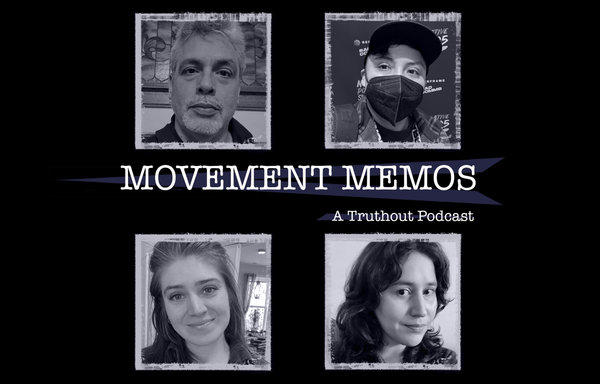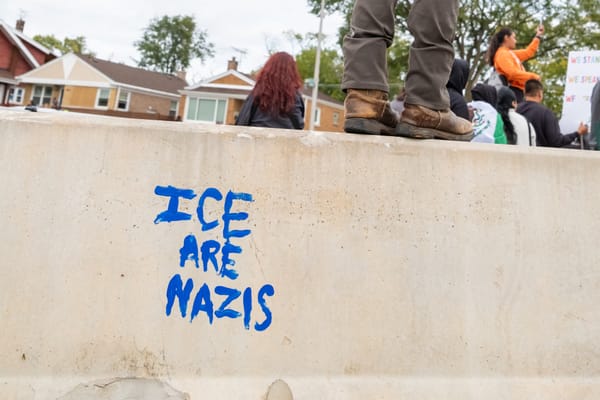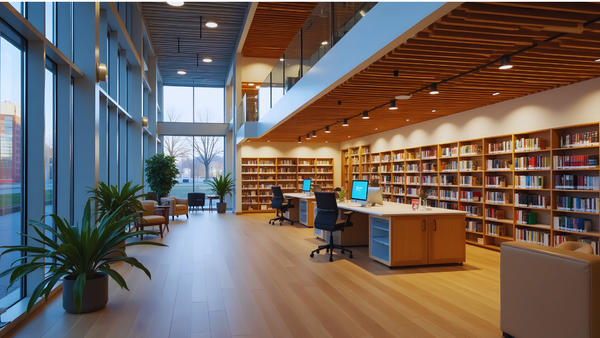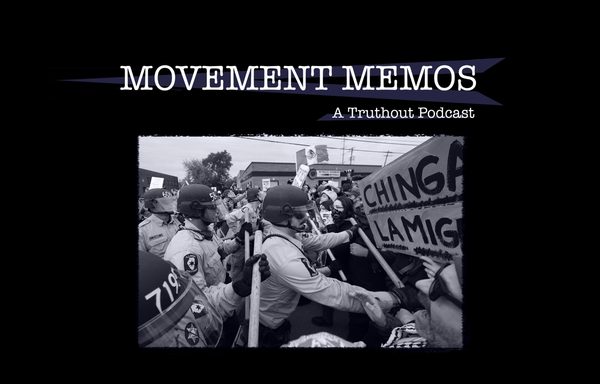They Came for Our Neighbors. We Showed Up.
Before long, there were dozens, and then hundreds of people in the streets, watching and responding.
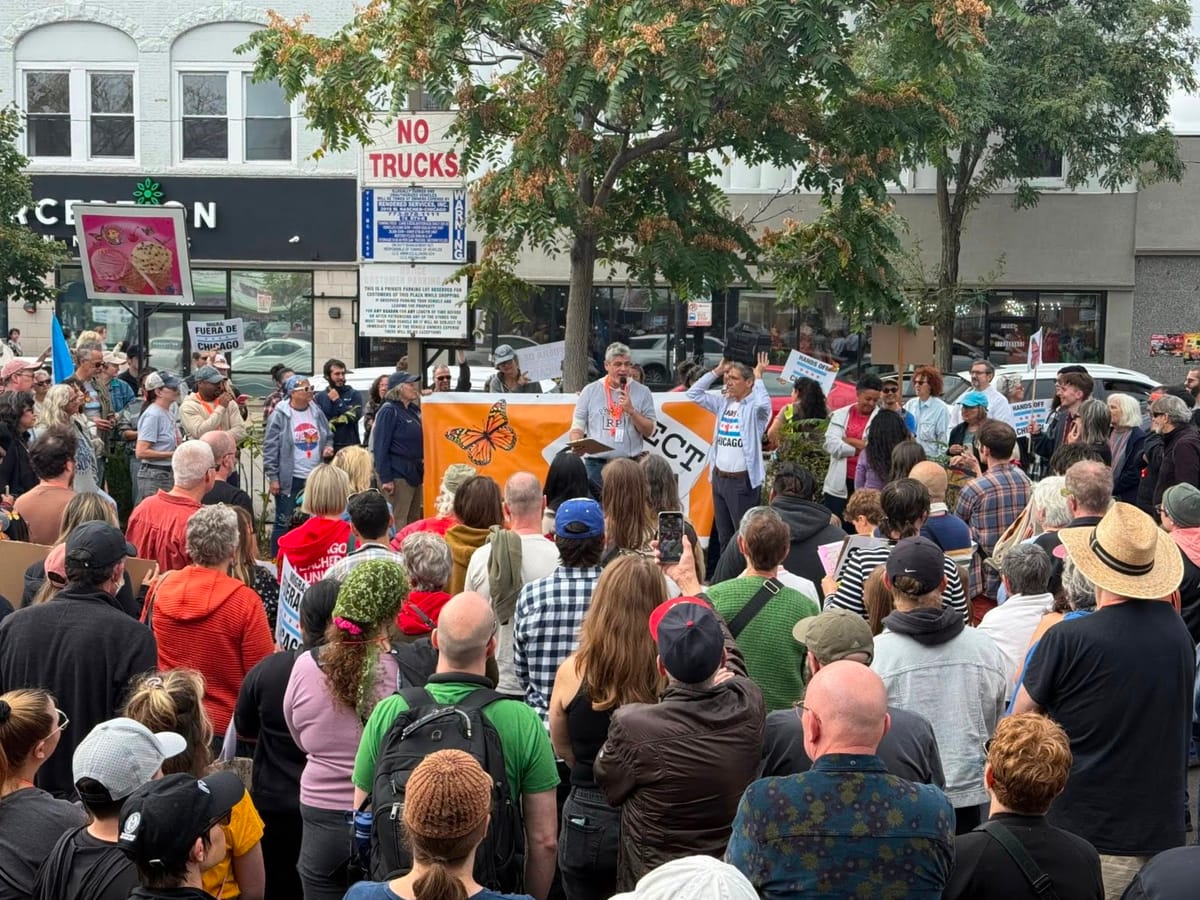

I was still groggy, drinking my morning tea, when my phone started buzzing with alerts about ICE hitting a corner within walking distance of my home. At first, it was unclear if they had taken a street vendor who was familiar to many of us. Soon, we learned that the vendor was still there, but that two other neighbors had been seized.
That series of texts would soon activate a neighborhood.
I left my apartment on foot, in the clothes I had slept in, and made my way up Clark Street, watching for any signs of ICE. When I saw a suspicious vehicle, I relayed what I’d seen through neighborhood channels that coordinate ICE watch activity. When I reached the intersection of Clark and Lunt, where the abductions had occurred, other neighbors, including some old friends of mine, were already assembling and taking directions from local organizers who had been preparing for this moment for months.
While some parts of Chicago have been targeted relentlessly during the recent federal onslaught known as “Operation Midway Blitz,” Rogers Park had seen more scattered reports of ICE activity—until Thursday, when their presence was confirmed at the start of the day with immigration arrests, and continually reported throughout the morning and afternoon. Neighbors fanned out, searching streets and alleyways for any sign of ICE activity, following up on reports, and communicating what we found. Before long, there were dozens, and then hundreds of people in the streets, watching and responding.
“Clark Street was flooded with people,” Daniel*, an activist with Protect RP, told me. “We had over 200 people on the streets. That was power.” Daniel noted that many people left work early, or “dropped whatever they were doing” to join the effort.
Longtime ICE watchers wore bright orange whistles around their necks, which are used to signal the presence of ICE. Newcomers received whistles from volunteers distributing them in the streets, making the crowds of ICE watchers a clear presence. The corridor of businesses on Clark Street, where many immigrants shop and work, was clearly defended by this mass presence.
Wherever I went Thursday, to follow up on a reported ICE sighting, I was quickly met by many neighbors—and often, they were already there when I arrived. We talked to witnesses who had spotted ICE. We talked to business owners and concerned staff at schools. When people spotted vehicles that had been identified as belonging to ICE, they blew their whistles and jeered loudly, making locations as inhospitable to ICE as possible, while also warning vulnerable people nearby that ICE was present.
“[ICE] had a much harder time trying to take people because there were so many watchers out observing and confronting them,” Rosemary, an organizer with Rad Rogers Park, told me. “Everybody had their orange whistles on, and they were clearly ready. ICE had to be a lot more careful about where they were hitting, and so it was a lot harder for them to take more people.”
In some cases, people on bikes and in cars followed ICE vehicles to track their movements, and even blocked vehicles or otherwise obstructed their path. These actions are risky, as ICE has a history of using chemical weapons and committing other acts of violence against people who attempt to block their vehicles. In one incident, a woman who allegedly blocked in ICE vehicles with her car in Brighton Park—who has also been the subject of other highly questionable allegations—was shot by an ICE agent on October 4, in a moment that stirred another community mobilization.
On Sunday, ICE agents arrested one rapid responder in Rogers Park and pulled their guns on at least three others. In east Albany Park, ICE agents targeted rapid responders with tear gas. “This activity is not risk-free,” Manuel, an organizer with Protect RP told me on Sunday. “People have to make their own decisions—and we are not going to judge anybody for making any decision about what their risk level is, because we don't walk in their shoes, we just walk next to them.” Manuel did offer advice to rapid responders who are trying to remain as safe as possible. “Our first advice to people is to don't do this alone,” he said. “The feds seem to be more cautious when we are in groups, which makes perfect sense because they're bullies.”
Despite the risks, people on the ground are making autonomous decisions about how to confront the violence in their communities as it occurs, and even though these actions are not bound by a unified directive, they are all committed in the interest of solidarity and community safety.
Our city has been rendered wholly unsafe for immigrants, or for anyone who federal agents might profile as an immigrant. To get to work, to take their children to school, to move about their communities, immigrants in Chicagoland must engage with risk. ICE could seize them at the bus stop, at the gas station, or from their own beds in the night. So, some of us have elected to defend immigrants by stepping into zones of unsafety ourselves. For many, this involves taking risks, from the risk of being unlawfully detained by ICE agents while exercising the legal right to film an immigration arrest, to the risk of placing one’s body or vehicle in the way of ICE’s work, or the risk of facing the violence of ICE agents or state police while protesting near the Broadview ICE facility. We are taking these actions to defend our neighbors, the sanctity of our values, and the character of Chicagoland. This is a place where immigrants are loved, needed, and appreciated, and we will not give up members of our beloved communities without a fight.
Some people participated in Thursday’s mobilization remotely, by managing communications between people on the ground or staying in touch with people who were patrolling without a buddy. Maisie, an activist with Protect RP who helped coordinate communications on Thursday, told me that as a disabled person, “to be doing things that were accessible to me physically was really important.” She emphasized that “everybody has a place in this movement and everybody can do something.” As we spoke at a community gathering on Saturday, Maisie told me, “There are people right now who are folding brochures to be sent out in walk packets that we just decided to put together, and people are going to get materials because of them.”
As we took action together on Thursday, we were also aware that this single day of frenzied ICE activity was a daily reality for some neighborhoods across the city. Some of us showed up on Thursday in ways that we wouldn’t be able to if this level of ICE activity were a daily occurrence. As I moved from one reported ICE sighting after another, I felt tremendous empathy for organizers in Pilsen, Little Village, and other neighborhoods for whom this level of federal aggression is a daily grind. They are exhausted. They are constantly grieving the loss of neighbors. And they are also constantly teaching neighborhoods like mine lessons about how to mobilize and respond in the face of shifting conditions.
This is not a story about a moment of victory, but a moment of being reminded of our power. “It took months of us building infrastructure and relationships for something like Thursday to happen,” Rosemary told me.
Being a part of that fabric of relationships and preparedness is rewarding, but it can also be challenging—especially for people who are accustomed to the straightforward intensity of frontline protest. While Rapid Response sometimes involves confrontation, it can often feel like an unfinished sentence or an unanswered question. When we follow up on reports at locations ICE has targeted and left, or may never have been, or patrol fixed areas as a preventative measure, there is a lot of uncertainty, and often, we are holding space as a deterrent, documenting events, or comforting our neighbors, rather than squaring off with the forces that are harming our communities. It’s a form of resistance that requires us to put aside ego, and the need for personal gratification, to become a node in a living network of care, support, and defense.
Maisie urged people who feel moved to protect their communities to find a way to get involved. "Get out, meet some people, get involved in the groups that are doing this," she said. “There are ways for literally everybody to do something, and we have to do it because no one else is going to do it.”
We cannot prevent all of the harm that ICE will do in our communities, but we can make their work harder, and we can make our values, our presence, and our solidarity known. We can make our neighborhoods and our relationships stronger, as we forge bonds in opposition to this violence. On Saturday, nearly 500 people gathered in Rogers Park to protest the recent ICE activity in the community, mourn the theft of those taken, and celebrate the community mobilization that formed in response. Attendees were also encouraged to support businesses on Clark Street, to keep the area active and prosperous in the face of federal attacks.
On Sunday, ICE alerts in Rogers Park began early, with more sightings and arrests, and continued into the afternoon. Many of us took to the streets again, and will continue to do so. Because our community is worth fighting for.
* The names of all activists quoted in this piece have been changed in an effort to protect interviewees from doxxing and targeted repression.
Organizing My Thoughts is a reader-supported newsletter. If you appreciate my work, please consider becoming a free or paid subscriber today. There are no paywalls for the essays, reports, interviews, and excerpts published here. However, I could not do this work without the support of readers like you, so if you are able to contribute financially, I would greatly appreciate your help.

